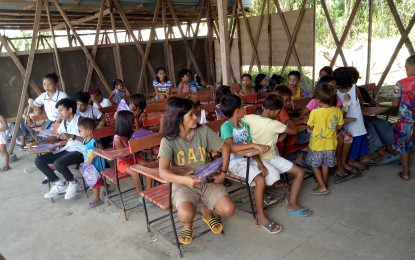
MAKESHIFT CLASSROOM. Parents and children inside a makeshift classroom at Villa Sofia Elementary School in Tagpuro village, Tacloban City. Over 3,500 children will attend classes in temporary classrooms built within Yolanda housing projects starting next week. (PNA Tacloban photo)
TACLOBAN CITY -- Over 3,500 children will attend classes in makeshift classrooms starting next week as the central government will have to build more permanent classrooms within relocation sites meant for families badly hit by super typhoon Yolanda in 2013.
DepEd Tacloban City Division Superintendent Thelma Quitalig said there are still 88 temporary learning spaces that will be used by children of families transferred to northern relocation sites, from coastal communities devastated by super typhoon Yolanda.
Of the seven new schools, only two campuses have permanent classrooms. At least five new campuses will have to use makeshift rooms made up of coconut lumber, plywood, and corrugated iron sheets.
“While waiting for funds from our central office requested early last year, we have to make use of these temporary learning spaces (TLS) as we acknowledge that education is one of the basic needs of children of relocated families,” Quitalig said on Monday.
The official confirmed that these TLS were constructed last year, but were not used by learners since some permanent houses are still unoccupied.
The government aims to move more than 14,000 typhoon-hit families to northern relocation sites. About 10,000 families have been transferred to their new homes, away from threats of storm surges.
Mabel Lima, 33, a mother of three, whose house is just a stone throw away from the new campus in San Jose district, thanked the education department for setting up temporary classrooms. Two of her children are in elementary school supported by her husband's meager income from fishing.
“Although these are just makeshift rooms, it’s safer than their previous school since these are far from the main highway. We are thankful that there are classrooms near relocation sites so we don’t have to spend a lot for transportation,” said Lima, who settled in coastal San Jose district when Yolanda struck.
Grade 7 learner Beverly Shane Albesa, 11, is ready to endure the heat inside TLS at the Guadalupe Heights Integrated School in San Isidro village. When she transferred to the new campus last year, it’s just normal to share a room with 40 other sweat-soaked children during sunny days.
“It’s inconvenient but I have to pursue my studies because I want to be a flight attendant someday,” said Beverly, accompanied by her father and two younger siblings in their kindergarten age.
Due to shortage of walling materials, the room is partly exposed to sunlight early morning and late in the afternoon. The floor, which was not concreted, also raises concern that it might become muddy during rainy days.
Aside from Villa Sofia and Guadalupe Heights housing projects, the education department has been maintaining makeshift rooms for North Hill Arbour, Greendale Residences, and New Hope Village.
Quitalig is hopeful that their main office will download the budget for new building and find new sites for buildings originally intended in some areas, which failed the soil stability test for three-storey school buildings. The city needs 656 new classrooms for new campuses and additional 40 rooms for existing schools.
“Since these are new schools operating on minimal budget, we invite our stakeholders who have the heart and means to offer help to our schools,” Quitalig said during the city’s kick off of Brigada Eskwela 2018 at Villa Sofia Elementary School in Palanog village.
Brigada Eskwela or the national schools maintenance week, aims to bring together all education stakeholders to participate and contribute their time, effort and resources to prepare public school facilities for the opening of the academic year on June 4. (With reports from Chanda Mae Dialino and Princess Rosette Cabonegro, OJTs/PNA)
